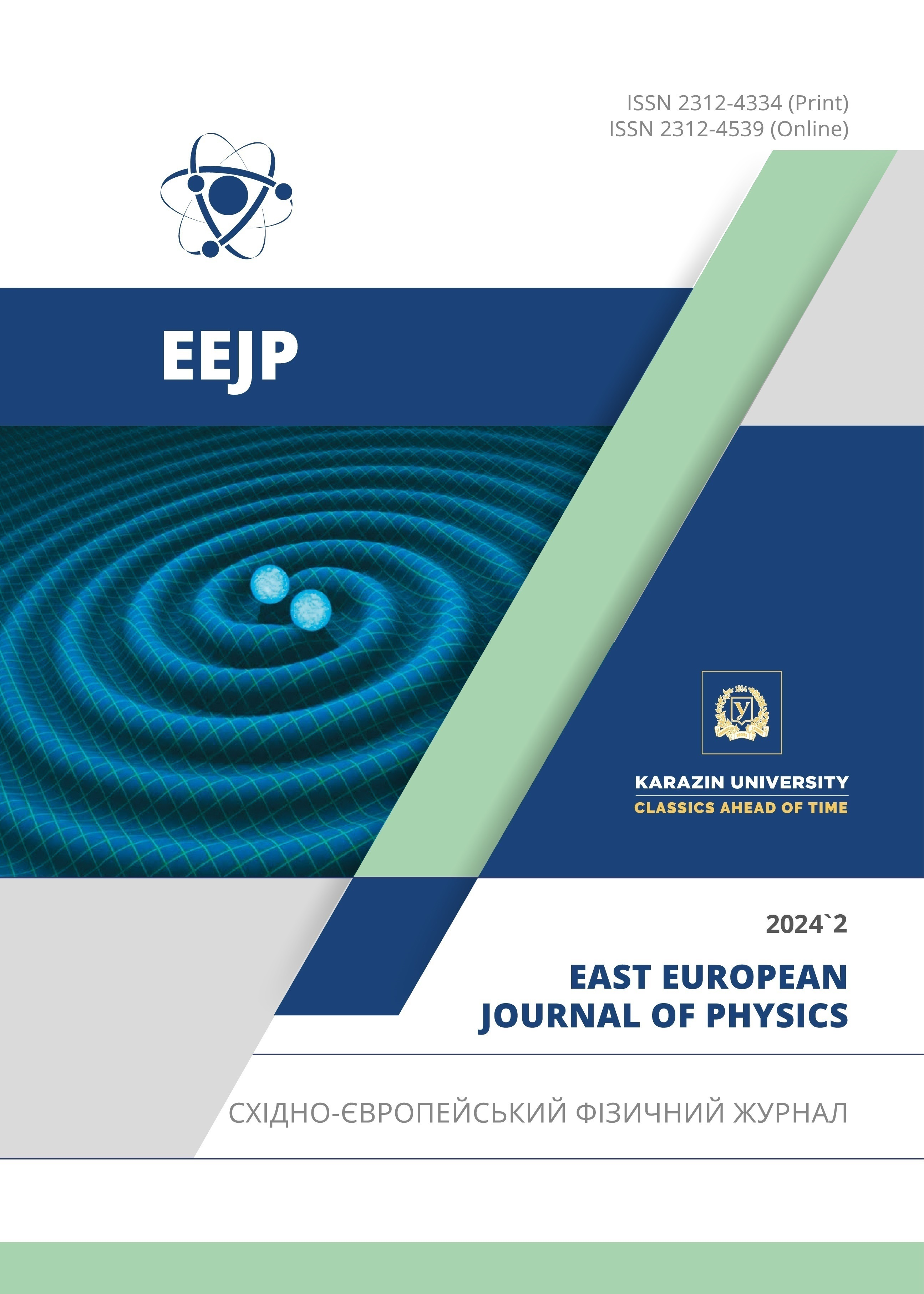Morphology of the Surface of Silicon Doped with Lutetium
Abstract
In this paper, using a scanning electron microscope (SEM) and atomic analysis, the location map of microcomposites formed on the surface of n-Si, p-Si, n-Si<Lu> and p-Si<Lu> samples was studied. Force microscope (AFM) research devices. The atomic fractions of inclusions of carbon, oxygen and lutetium formed on the surface of the samples were studied. Also, using the ASM device, the sizes, relief and topographic appearance of defects formed on the surface of the samples were determined. In silicon samples doped with Lu, a decrease in the size of surface defects and the formation of nano-sized structures were found, which makes it possible to obtain materials with a more perfect crystal structure. Using a ZEISS GeminiSEM 300 scanning electron microscope, the structural structure, chemical composition and images of their arrangement of n-Si, p-Si, n-Si<Lu> and p-Si<Lu> samples were obtained. In this case, the electron accelerating voltage was 20 kV, and the pressure in the sample chamber was (10-3 mmHg). Research results show that the structural structure of micro- and nanocomposites formed in silicon mainly depends on the diffusion time and cooling rate of the samples after diffusion annealing.
Downloads
References
К.V. Ravi, Imperfections and impurities in semiconductor silicon, (Wiley, New York, 1981).
H. Wang, Y. Nyu, H. Lin, J. Qiao, Y. Zhang, W. Zhong, and S. Qiu, “Modification of rare earth Ce by inclusions in non-oriented silicon steel W 350,” Metals, 13, 453 (2023). https://doi.org/10.3390/met13030453
Sh.B. Utamuradova, A.V. Stanchik, and D.A. Rakhmanov, “X-Ray Structural Investigations Of n-Si Irradiated with Protons,” East Eur. J. Phys. 2, 201 (2023). https://doi.org/10.26565/2312-4334-2023-2-21
Sh.B. Utamuradova, H.J. Matchonov, Zh.J. Khamdamov, and H.Yu. Utemuratova, “X-ray diffraction study of the phase state of silicon single crystals doped with manganese,” New Materials, Connections Oath Applications, 7(2), 93-99 (2023). http://jomardpublishing.com/UploadFiles/Files/journals/NMCA/v7n2/Utamuradova_et_al.pdf
N.M. Bogatov, L.R. Grigoryan, A.Y. Kovalenko, M.S. Kovalenko, F.A. Kolokolov, and L.S. Lunin, FTP, 54, 144-148 (2020). https://doi.org/10.21883/FTP.2020.02.48909.9255
Kh.S. Daliev, Sh.B. Utamuradova, J.J. Khamdamov, and Z.E. Bahronkulov, “Electrophysical properties of silicon doped with lutetium,” Advanced Physical Research, 6(1), 42-49 (2024). https://doi.org/10.62476/apr61.49
B.I. Boltax, Diffusion in semiconductors, (Moscow, State Publishing House of Physical and Mathematical Literature, 1971). (in Russian)
S.B. Utamuradova, Z.T. Azamatov, M.A. Yuldoshev, N.N. Bazarbayev, and A.B. Bakhromov, “Investigations of Nonlinear Optical Properties of Lithium Niobate Crystals,” East Eur. J. Phys. (4), 147 (2023). https://doi.org/10.26565/2312-4334-2023-4-15
Sh.B. Utamuradova, S.A. Muzafarova, A.M. Abdugofurov, K.M. Faizullaev, E.M. Naurzalieva, and D.A. Rakhmanov, Applied Physics, 4, 90 (2021). https://applphys.orion-ir.ru/appl-21/21-4/PF-21-4-81.pdf
Daliev, K.S., Utamuradova, S.B., Khamdamov, J.J., Structural properties of silicon doped rare earth elements ytterbium. East European Journal of Physics, (1), 375–379 (2024). https://doi.org/10.26565/2312-4334-2024-1-37
Yu.S. Katarria, S. Kumar, F. Singh, J.K. Pivin, and D. Kanjilal, “Synthesis of buried SiC using an energetic ion beam,” J. Phys. D: Adj. Phys. 39, 3969–3973 (2006). http://dx.doi.org/10.1088/0022-3727/39/18/007
I.S. Smirnov, I.G. Dyachkovan, and E.G. Novoselova, “High resolution X-ray diffraction study of proton irradiated silicon crystals,” Modern electronic materials, 2, 29–32 (2016). http://dx.doi.org/10.1016/j.moem.2016.08.005
Kh.S. Daliev, Z.E. Bahronkulov, and J.J. Hamdamov, “Investigation of the Magnetic Properties of Silicon Doped with Rare-Earth Elements,” East Eur. J. Phys. (4), 167 (2023). https://doi.org/10.26565/2312-4334-2023-4-18
O.V. Skalyaukh, “Defect formation in silicon when irradiated with alpha particles with an energy of 5.4 MeV,” Ph.D. thesis, Ulyanovsk, 2000. (in Russian)
Kh.S. Daliev, Sh.B. Utamuradova, Z.E. Bahronkulov, A.Kh. Khaitbaev, and J.J. Hamdamov, East Eur. J. Phys. (4), 193 (2023). https://doi.org/10.26565/2312-4334-2023-4-23
V.A. Zinoviev, Ph.D. Thesis, “Processes on the silicon surface under the influence of low-energy ions under molecular beam epitaxy conditions,” Siberian Branch of the Russian Academy of Sciences, Institute of Semiconductor Physics, Novosibirsk 2004. (in Russian)
S.M. Osadchiy, A. Petukhov, and V.B. Dunin, “Application of silicon detectors with differential discriminators in X-ray diffractometers,” Journal of Surface Investigation X-ray Synchrotron and Neutron Techniques, 8, 25–29 (2019). (in Russian)
Copyright (c) 2024 Khodjakbar S. Daliev, Sharifa B. Utamuradova, Jonibek J. Khamdamov, Zavkiddin E. Bahronkulov

This work is licensed under a Creative Commons Attribution 4.0 International License.
Authors who publish with this journal agree to the following terms:
- Authors retain copyright and grant the journal right of first publication with the work simultaneously licensed under a Creative Commons Attribution License that allows others to share the work with an acknowledgment of the work's authorship and initial publication in this journal.
- Authors are able to enter into separate, additional contractual arrangements for the non-exclusive distribution of the journal's published version of the work (e.g., post it to an institutional repository or publish it in a book), with an acknowledgment of its initial publication in this journal.
- Authors are permitted and encouraged to post their work online (e.g., in institutional repositories or on their website) prior to and during the submission process, as it can lead to productive exchanges, as well as earlier and greater citation of published work (See The Effect of Open Access).








